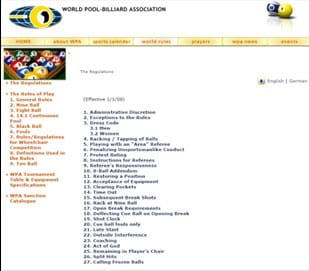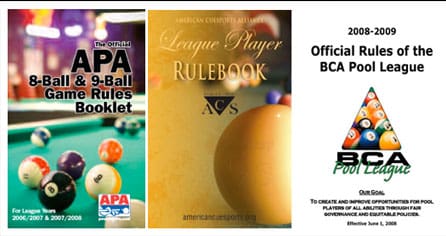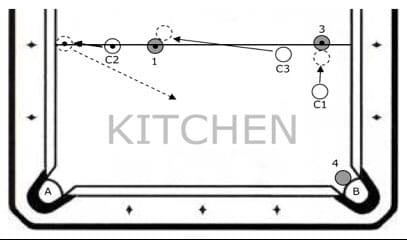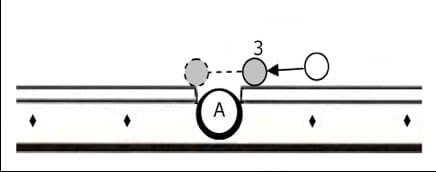League Information
(Courtesy Playbca.com)
THE CREATION OF THE BCAPL RULES
When Mark Griffin purchased the BCAPL, he realized that roughly 65,000 players had no set of rules to specifically govern league play. The prior organization had been using World Standardized Rules for many years – rules which were predominantly written for professional play and often criticized for their inconsistency. Mark realized the only way to rectify the situation was to create “The Official Rules of the BCAPL”.

In late 2006, Mark put together a team to begin this massive project. Leading the group was BCAPL Rules Administrator Bill Stock. National Senior Referees Buddy Eick and Ken Shuman served as Technical Editors. Over the next 6 months, the team solicited input from its league operators and players. They researched the history of league play, consulted with their current referee staff, and reviewed rule books and formats produced by other sports organizations. Mark provided the necessary policy guidance on behalf of the National Office.
By August 2007 a final draft was ready and the first edition of the Official Rules of the BCAPL became effective on October 1, 2007. The second edition was released on June 1, 2008, and will be updated on June 1 of each year.
We believe our product is the most complete, detailed, and easy to understand set of rules in the industry today. Others seem to share our opinion. World-renowned billiard historian, author, and rules expert Mike Shamos agrees that the BCAPL has taken a major step in improving the game. The following article, reprinted here with his permission, appears in the July 2008 edition of Billiards Digest:
Who Makes the Rules?
Every billiard organization has its own set of specifications and regulations by Mike Shamos.
Happy Anniversary! In 1993, the Billiard Congress of America (BCA) said it was adopting the World Standardized Rules (WSR) of the World Pool-Billiard Association (WPA). It didn’t actually adopt them at the time, but it incorporated some of them into its rule book. Every year since, the BCA has claimed to follow the WSR without really doing so. Until now. The latest version of the BCA rule book has finally absorbed all of the World Standardized Rules and equipment specification. The process only took 15 years.
I’ve been following this all very closely, as you’ll see. When I was in college in the 1960s, I saw the BCA rule book for the first time. I was fascinated. It was the wonderful 1967 edition that codified 9-ball for the first time. Ever since then, I harbored a secret desire to be on the BCA Rules Committee. I never told anyone. After I started writing for Billiards Digest, I created the “You Make the Call” column, which pointed out what I felt were significant lapses in the rules. Maybe they figured that if I were on the inside I would stop complaining, so in 1999 I got the call inviting me to be on the Rules Committee? Joy of joys! Now I would be in a position to so something about them instead of just criticizing. Life was good.
But life sometimes doesn’t turn out as expected. I made so much trouble on the committee that the BCA disbanded it less than two years later without adopting a single one of my suggestions.
My usual quarrel is not that a particular rule is worded wrong, or that it makes no sense. Both of these sometimes happen. My problem is that the rules are often inconsistent. Sometimes three different rules cover the same situation and each one provides for a different outcome. What can you do with that? The rules are also incomplete since lots of things happen in games that aren’t covered at all. Call me names, if you will, but I think the rules should be logical, unambiguous and as thorough as possible. You can be sure that without a good collection of rules you’ll never see billiards as an Olympic event.
In 1993, the BCA revised its rules to include some of the World Standardized Rules (Fig. 1). To understand exactly what was done, you have to look at their structure. Since 1993, the rules have been divided into four distinct sections: “Rules for Tournament Play,” “Instructions for Referees,” “General Rules of Pocket Billiards” and rules of specific games, especially 8-ball, 9-ball and straight pool. What the BCA did in 1993 was conform those three specific game rules to the World Standardized Rules. From 1993-2008, the “Rules for Tournament Play,” “Instructions for Referees,” and particularly the “General Rules of Pocket Billiards” remained unique to the BCA and did not follow the WPA.

1. The World Pool-Billiard Association published the “Word Standardized Rules.”
In 1994, the BCA agreed to a five-year moratorium on any changes to the World Standardized Rule. I didn’t like that – it’s like an agreement that the city won’t fix any potholes for five years. Why not? If a rule has flaws, why shouldn’t it be changed? The 1994 BCA rule book stated, “The BCA Rules Committee will continue to meet once each year to serve as guardians of the standardized rules.” You might find the term “guardian” a little pompous, but don’t worry – the only thing the committee guarded against was anyone changing anything, especially me. Why meet during the moratorium? By 2001, the BCA Directors figured out that there was no point in having a rules committee at all if it wasn’t going to make any rule, which is where things still stand today – there isn’t one.
In this month’s Mailbag, Dave Merrill asks why I keep referring to the BCA rules in my “You Make the Call” column when the BCA has adopted the World Standardized Rules. The answer is that until this month the BCA hadn’t, but now it has. So starting with the next issue, Dave, I will no longer refer to the “BCA” rules
Even now, it’s a little tricky to find out what the BCA rules actually are. The main BCA website, www.bca-pool.com, has last year’s rule posted. Its alternative website, www.generationpool.com, includes the WPA General Rules (which replaces the BCA General Rules), but not the WPA Regulations. The 2008 BCA Official Rules and Records Book has the complete World Standardized Rules for the first time. So stick with the published rule book – that’s always the safest course anyway. It probably won’t be long before all three rules sets are identical and things will calm down.
Sort of. A remaining problem is that the BCA isn’t the only organization in the country that holds competitions and therefore needs a set of rules. To name a few, we have the Valley National Eight-Ball League Association (VNEA), the American Poolplayers Association (APA), the American Cuesports Alliance (ACS) (Fig. 3) and the BCA Pool League (BCAPL) (Fig. 4). Each of these has a different set of rules, and sometimes the differences are substantial. All of the rule sets mentioned in this article can be found at the websites of the named organizations (except the BCA, as explained above.)

2. The American Poolplayers Association Rules are just 17 pages long.
3. The American Cuesports Alliance follows the BCA rules.
4. The BCA Pool League (BCAPL) rules include extensive interpretations for the first time.
Here’s a simple example of what happens when different bodies put out different rules. You probably think you know how to lag for break. You don’t. Or, to put it another way, whatever method you use is wrong according to some organization. Under ACS rules, the players each get ball in hand behind the head string. The WPA requires that the “referee will place a ball on each side of the table behind the head string and near the head string.” I don’t know the difference between “near” and not near. Is 12 inches near? I don’t like either version. Under Union Mondiale de Billard (UMB) carom rules, the balls are placed on the head string 30 centimeters from the side cushions so there is no human judgment or variability.
That’s not all. Who actually wins the lag? The ACS rules states that the “player whose ball is the closest to the innermost edge of the head cushion wins the lag.” The WPA says that the player wins whose ball is “closer to the head cushion than the opponent.” It’s the “innermost edge” thing that I don’t get. What does it even mean – the edge closest to the playing surface? If a ball is on the table bed (and it has to be for a player to win the lag), then the closest point to it on the head cushion has to be on the edge that borders the playing surface. So the “innermost edge” language is unnecessary and confusing.
What about timing? When do you have to hit your ball when lagging? The APA rule book says that “Players simultaneously shoot a ball from behind the head string.” Well, that can’t be true. Maybe they meant “approximately simultaneously,” but then how many seconds would be approximate? In any event, no penalty is provided if one player shoots much later than the other, although presumably the referee would have the power to declare him the loser, even though the rules don’t say that. The WPA and the UMB say the lag is repeated if you hit your ball after your opponent’s ball contacts the foot cushion. I think the latter rule is excellent because it doesn’t require stopwatches to time the players.
So far we have four different organizations who don’t even agree on how to determine who shoots first. Do you thing it gets any better once the game actually starts?
If you want to see a well-drafted set of game rules, you won’t do better than those of the United States Golf Association (USGA), called “Decisions of the Rules of Golf.” Unfortunately, they don’t talk about billiards, and at 580 pages you might find them a bit unwieldy, but a lot happens on a golf course that we don’t usually have to worry about on a pool table, such as animals carrying away the balls. This is rarely a problem in our game except in the most raunchy establishments. (You have to love a set of rules that declares a live snake to be an “outside agency” but a dead snake is a “loose impediment.”) What I like about the USGA rules is that every situation is covered in one and only one place, so ambiguities do not creep in as the rules are modified, and that the “decisions” part of the book covers a huge number of interpretations of the rules (it’s available on CD), along with the reasoning used to arrive at the decision. This means that the logic behind the rule can be evaluated and debated, and if the nature of the game or the equipment changes, the rule can be revised appropriately. It also helps in applying the rule to new factual situations that haven’t come up before.
Unfortunately, the billiard community has not followed the example of the USGA. Our rules are mysterious, and I’m constantly getting questions about the reason behind this or that rule. For example, the BCA and WPA used to require that the opening rack in straight pool had to have the 1-ball on the right corner (as seen by the racker) and the 5-ball on the left corner. No explanation at all was given for this rule, which actually makes great sense. The opening breaker must drive at least two balls to cushions. Using the normal safety break, this makes the corner ball contacted hit the foot rail and the other corner ball the opposite side rail. The referee has to watch both of these balls at the same time to make sure that contact occurs. It helps if there is strong visual contrast between the green of the cushion and the colors of the balls. The 1-ball is bright yellow and the 5-ball is bright orange, providing the greatest possible contrast with green. In the January 1, 2008 revision of the WPA rules, this perfectly fine rule just disappeared – vanished like something in the wind. Nobody said goodbye, or offered a word of explanation. My suspicion is that since the rationale for the rule may have been lost to history (it was never written into the rule), the rulemakers saw no reason to keep it.
I’m pleased to report that things seem to be changing. The 2007-2008 Official Rules of the BCA Pool League are, at 85 pages, the most extensive set of rules in history, and for the first time they are accompanied by interpretive decisions. It’s curious that the BCA Pool League doesn’t use the BCA rules, but I can hardly fault them for that since I’ve raised about 100 objections to the BCA rules over the past 14 years, thus making a career of being ignored. Here’s a quote from League CEO Mark Griffin’s introduction: “The recent history of the development of billiards rules has not been as friendly to the player as it could have been, particularly to the amateur player that the BCAPL is dedicated to serving. Rule changes and wording changes have been confusing and difficult to understand over the years. Interpretations have frequently changed and have never been made available in print. The interpretations lived only in the realm of the referee’s and administrator’s communities, where further inconsistency only compounded the problem.” I agree with this assessment completely.
I could go through a long catalog of places where the BCAPL rules improve on the WPA rules, but you’ll have to be content with some examples. Things get off on the right foot very early. Rule 1.3, “Use of Equipment” states, “You may use only your cue stick, held in your hand or not, to align a shot.” WPA Rule 6.12, “Cue Stick on the Table,” reads, “If the shooter uses his cue stick in order to align a shot by placing it on the table without having a hand on the stick, it is a foul.” I think the “hand on the stick” requirement is silly, since it can be used to penalize a player who happens to lay his stick on the table inadvertently. And what’s a hand? If you’re touching the cue stick with your fingernail, does that count?
No such problem in the BCAPL rules. Its rule 1.3 goes on to say, “You may not use any ball, your cue stick, the rack, or any other equipment or width-measuring device to determine if the cue ball or any object ball would fit through a gap or to judge what ball the cue ball would contact first.” Not only is the rule a good one, but the situation is treated in one and only one place so there’s no possibility of ambiguity. The “Applied Rulings” section deserves serious study. It is of course impossible to write a rule set that deals with every conceivable happenstance. Even the USGA rules don’t try to do that. Therefore, referees and tournament directors must be guided by interpretations so they can make intelligent rulings when new situations arise. Here’s a BCAPL interpretive comment about the “cue for aiming” rule: “Situation: Player A lays their cue stick on the table to help line up a shot, then takes a second cue stick in hand to assist as well. Ruling: Illegal. Only a single cue stick, held in the hand or not, may be used.” There’s no provision in any set of billiard rules that explicitly says that only one cue stick may be used during a shot. Certainly you can’t hit a cue ball with two different cues. Talk about a double hit! But why can’t you use more than one cue in aiming? Because you can’t use two baseball bats (except in warmup!) or two tennis rackets – to do so would violate the spirit of these games. I can easily imagine a thoughtful referee being stumped by the two-cue situation, though. If he called a foul, the offending player might say, “Show me the rule that says I can’t use two cues for aiming.” The BCAPL interpretation resolves the issue.
The BCAPL rule book is filled with drawings explaining the rules and decisions. Fig. 5 shows its clarification of legal and illegal shots with ball in hand in the kitchen. On the left, the cue ball C2 is shot to the left side rail with a lot of low left. It hits outside the kitchen and then returns to sink the 4-ball at pocket B. This is a legal shot. In the middle position, the cue ball C3 is in the kitchen and so is the 1-ball. The cue ball leaves the kitchen and then contacts the 1. This is a foul. The cue ball must contact a cushion or ball outside the kitchen before it is allowed to hit a ball that is in the kitchen. At the right, the cue ball C1 is in the kitchen but the 3-ball is not, even though part of the 3-ball lies in the kitchen. This one is legal. Pictures like these really promote clarity.

5. This BCAPL diagram explains the rule on shooting from the kitchen.
A tricky problem is illustrated in Fig. 6, also from the BCAPL rule book. The 3 has been examined and declared frozen to the cushion. The shooter hits the 3 and drives it across the side pocket mouth, where it hits the cushion and comes to rest. The cue ball does not contact any cushion. Is the shot legal? The answer is no. A ball frozen to a rail must be pocketed or driven to a different rail in this situation. The portions of the cushion on the two different sides of the side pocket are considered to be the same “rail,” so the shot is a foul.

6. This tricky foul is fully explained in the BCAPL rules.
It should be no surprise to you now that the BCAPL has included the UMB lag timing rule: “You lose the lag if your ball … is shot after your opponent’s ball contacts the foot cushion.” And of course the BCAPL has kept the 1 and 5 racking rule for straight pool. I’m not declaring their rules to be perfect, but they try to be. The rules themselves and their interpretations have been given a great deal of thought, and the reasoning behind them is not hidden but is right there on the page. They’re also based on a great deal of experience with problems that surfaced in actual league situations. They don’t make the mistake of sacrificing the integrity of the game just to keep down the number of disputes that arise, which is a flaw endemic to league rules generally. I have the feeling that because of their logic the BCAPL rules just may become the dominant rules of the game.
Mike Shamos is Curator of The Billiard Archive, a non-profit foundation set up to preserve billiard history.

Thursday Night is BCA League Night starts at 7:30pm
To join the BCA League contact Eric at 772-480-9054
NOTE: (6/1/2009) Since the publication of Mr. Shamos’ remarks, the ruling on the situation in Figure 6 has changed. The shot is now legal. Please refer to BCAPL Applied Ruling 1.19 for details.
